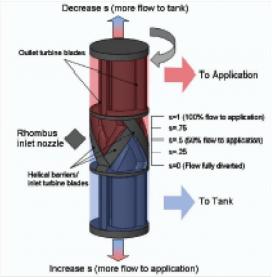Use of a Self-Powered Rotary PWM Valve for Improved Energy Efficiency in Fluid Power Systems
A self-spinning rotary pulse width modulation (PWM) valve has been developed, prototyped, and demonstrated by researchers at the Center for Compact and Efficient Fluid Power (CCEFP), an NSF-funded Engineering Research Center (ERC) headquartered at the University of Minnesota.
Current fluid power systems lose extensive energy from the metering control valves that dissipate energy through partially opened valve orifices. By replacing these valves with throttle-less methods, significant energy efficiency increases are possible. One approach to realizing throttle-less control includes PWM on/off valves that are either fully opened or fully closed. This approach models the use of switched mode converters adopted in power electronics.
A primary challenge to realizing PWM control of fluid power systems has been the lack of high-speed on/off valves. These on/off valves must have large orifices (to allow large flow to pass through at low pressure drops), fast transitions (to reduce the time when the valve is partially open), and the ability to operate at high PWM frequencies (to reduce ripple and to achieve high control bandwidth). Control valves typically consist of a linear translating element, such as a spool or poppet, which opens and shuts an orifice. Actuating such a valve at high frequency requires rapid acceleration and deceleration, which in turn requires large actuators and power input proportional to the third power of the frequency.
CCEFP’s self-powered rotary PWM valve is turned on and off as the spool rotates; the PWM duty ratio is adjusted by translating the spool axially. Since the spool is continuously rotating, rapid acceleration and deceleration is not required and the power input is proportional to the second power of frequency, allowing much faster operation. The CCEFP rotary valve also uses fluid momentum as a power source, so that no external rotary actuator is needed. To date, a 3-way version of the rotary on/off valve was integrated with a (40 lpm) fixed-displacement pump to achieve variable-displacement functions. The CCEFP prototype achieves PWM frequencies up to 90 hertz, closed-loop duty ratio modulation with 0-100 percent, and transition time of less than 0.1 seconds.


